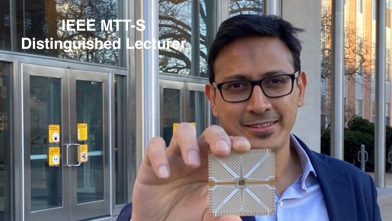
-
Wednesday, April 28, 2021 1:00 pm - 2:00 pm(UTC) Add to my calendar
Towards Universally Programmable Chip-Scale THz Source, Sensors and Systems: Bridging the THz and Application Gap in the Next Decade
Dr. Kaushik Sengupta
Princeton University, Princeton NJ, USA
IEEE MTT-S Distinguished Microwave Lecturer, Class 2021-2023
Abstract: Silicon-based Terahertz systems is a field that is only about a decade old. In this time, we have seen a phenomenal growth of silicon systems operating at THz frequencies for a wide range of applications in sensing, imaging and communication. It can be argued that both the ‘THz gap’ and the ‘technology and applications gap’ is closing in meaningful ways in the THz range. Technologies beyond 100 GHz focusing on sensing, imaging and wireless back-haul links are getting attractive as we enter into a new area of highly dense network of autonomous systems requiring ultra-high speed and reliable links.
In order to move beyond this inflection point as Moore’s law continue to slow, I will discuss why we need to look beyond the classical ‘device’-level metrics of efficiency and sensitivity of THz sources and detectors towards holistic ‘system’ level properties such as scalability and programmability. Such properties are critically important for applications in sensing and imaging, as evidenced across sensor fusion technologies across mmWave, IR and optical frequencies. The ultimate programmability in THz sources and sensors is one that can synthesize or receive THz fields with arbitrary configuration and spectrum. In this talk, I will highlight approaches that cut across electromagnetics, circuits, systems and signal processing, to allow for such reconfigurability in THz signal synthesis and sensing, yet realized with devices that are themselves not very efficient. Particularly, we will demonstrate approaches to THz CMOS sensors reconfigurable across the three field properties of spectrum (100 GHz-1000 GHz), beam pattern and polarization, programmable THz metasurfaces with CMOS tiling, and enabling dynamic spectrum shaping and physically secure sub-THz links. In the end, I will comment on what could be the major directions for the field in the coming decade.
Speaker’s Bio: Kaushik Sengupta received the B.Tech. and M.Tech. degrees in electronics and electrical communication engineering from IIT Kharagpur, Kharagpur, India, in 2007, and the M.S. and Ph.D. degrees in electrical engineering from the California Institute of Technology (Caltech), Pasadena, CA, USA, in 2008 and 2012, respectively. In 2013, he joined the Department of Electrical Engineering, Princeton University, Princeton, NJ, USA, as a Faculty Member. His current research interests include high-frequency ICs, electromagnetics, and optics for various applications in sensing, imaging, and high-speed communication.
Dr. Sengupta received the Bell Labs Prize (2017), Young Investigator Program (YIP) Award from the Office of Naval Research in 2017, the DARPA Young Faculty Award (2018), and the E. Lawrence Keys, Jr./Emerson Electric Co. Junior Faculty Award. He was six times selected to the Princeton Engineering Commendation List for Outstanding Teaching in 2014, 2016, 2017, 2018, 2019 and 2020, and received the ‘Excellence in Teaching Award’ from the School of Engineering at Princeton University in 2018 nominated by the Undergraduate and Graduate Student Council. He is currently serving as a steering committee member of IMS 2021 as workshop co-chair and as a member the MTT-4 Committee on Terahertz technology, and has served on the Technical Program Committee of the IEEE ESSCIRC, IEEE CICC, IEEE ICC and PIERS. He is co-recipient of the 2015 MTT-S Microwave Prize. He is currently serving as a Distinguished Lecturer for IEEE Solid-State Circuits Society (2019-2020), and will serve as a Distinguished Lecturer for IEEE Microwave Theory and Techniques (2021-2023).
This Lecture is sponsored by IEEE MTT Society DML Program, organized by IEEE AP-MTTS SBC, IIT Kharagpur.
Registration is Free but it is Mandatory. Online link will be shared only to registered participants.